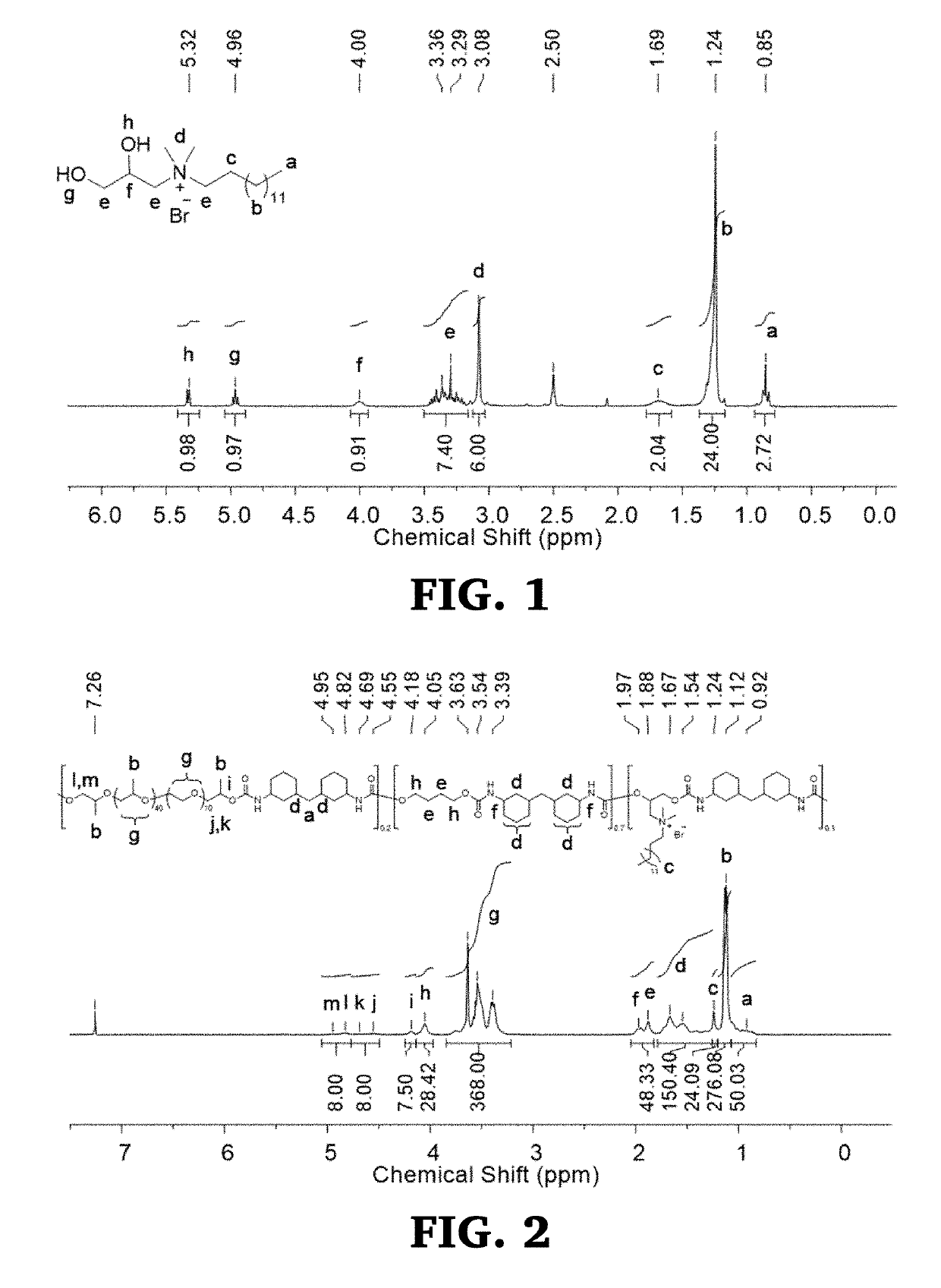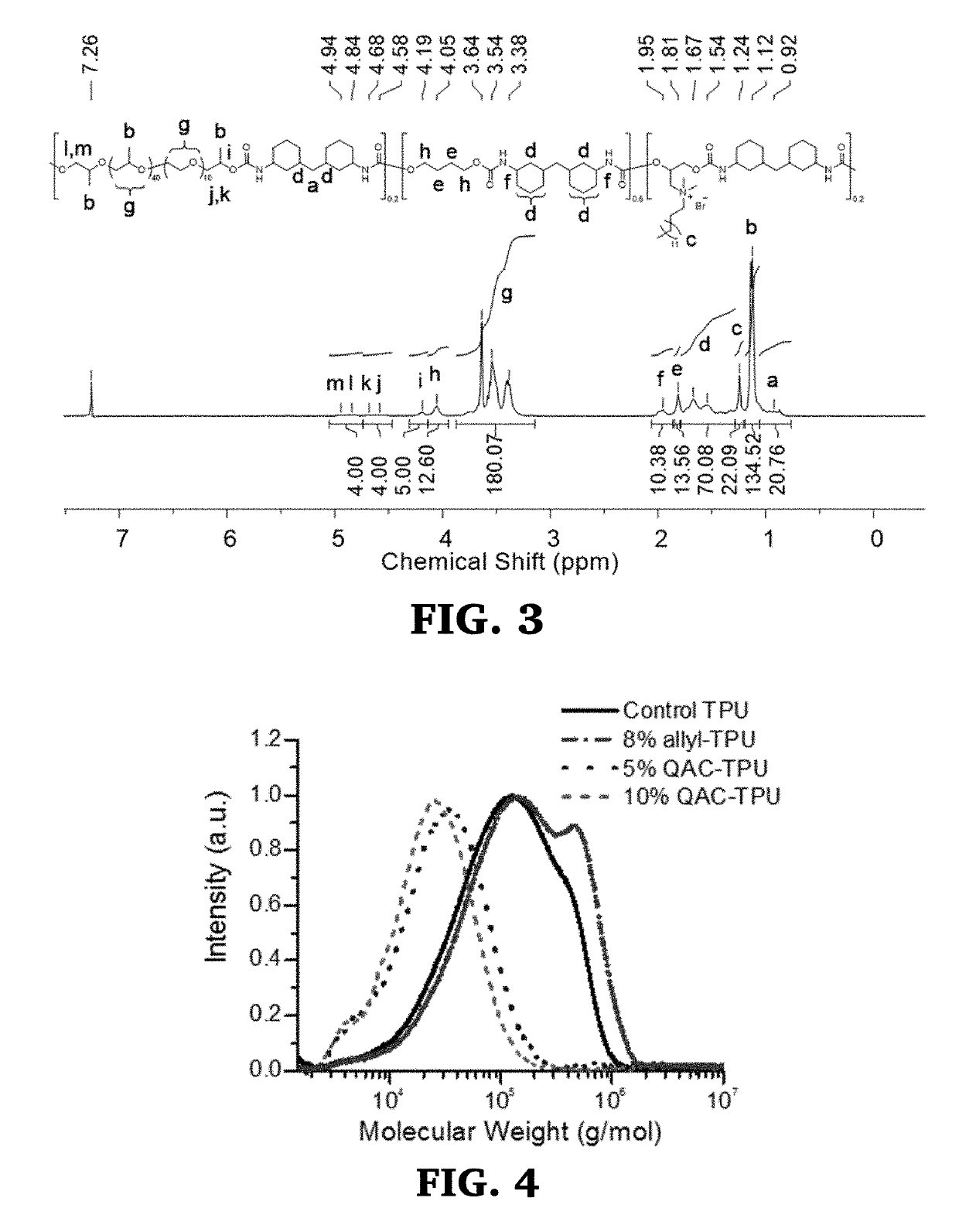Contact-killing, qac functionalized thermoplastic polyurethane for catheter applications
a functionalized, thermoplastic polyurethane technology, applied in the field of contact killing, can solve the problems of increasing the risk of developing antibiotic resistance via point mutation, reducing the ability of the immune system to clear the infection, and particularly the problem of catheter colonization,
- Summary
- Abstract
- Description
- Claims
- Application Information
AI Technical Summary
Benefits of technology
Problems solved by technology
Method used
Image
Examples
example 1
Quaternary Ammonium Diol “Q14-(OH)2” Synthesis
[0229]In a 100 mL round bottom flask, 14.0 g (90.3 mmol, 1.0 eq) of 3-bromo-1,2-propanediol and 50.0 mL (164.6 mmol, 1.8 eq) of DTDA were added. The reaction flask was gradually heated to 60° C. while stirring under N2 purge. A white precipitate began to form after 30 min, and the reaction was allowed to stir overnight. The crude product was precipitated in Et2O (3×), then vacuum dried for 24 h to afford 32.2 g (90.0% yield) of white, solid product. 1H-NMR (300 MHz, 303 K, DMSO-d6): δ=0.85 (t, 3JH-H=6.7 Hz, 3H), 1.24 (m, 22H), 1.69 (m, 2H), 3.08 (s, 6H), 3.18-3.48 (m, 6H), 4.00 (m, 1H), 4.96 (t, 3JH-H=5.5 Hz, 1H), 5.33 (d, 3JH-H=5.3 Hz, 1H) ppm.
example 2
Quaternary Ammonium Alcohol “x-Qz-OH” Synthesis
[0230]To obtain a series of x-Qz-OH compounds with various hydrocarbon spacer lengths (x=3, 6, 8) and alkyl chain lengths (z=8, 12, 14), several chlorinated alcohols and tri-substituted amines were utilized. The general procedure is exemplified by the following: for 3-Q14-OH, 11.4 mL (37.4 mmol, 1.25 eq) of DTDA was added to a 100 mL round bottom flask and cooled to 0° C. under N2 purge. Then, 2.5 mL (29.9 mmol, 1.0 eq) of 3-chloro-1-propanol was injected, and the temperature was gradually increased to 100° C. The reaction was allowed to stir overnight, which afforded a slightly yellow colored solid. After precipitation (3×) in Et2O, a pure white solid was obtained (7.9 g, 78.6% yield). For a table of reagent quantities used in the syntheses of the various x-Qz-OH compounds, see Table 8.
[0231]3-Q-14-OH. 1H-NMR (300 MHz, 303K, DMSO-d6): δ=0.86 (t, 3JH-H=6.7 Hz, 3H), 1.24 (m, 22H), 1.64 (m, 2H), 1.80 (m, 2H), 3.01 (s, 6H), 3.19-3.37 (m, 4...
example 3
Quaternary Ammonium Alcohol “Qx-OH” Synthesis
[0236]To obtain a series of Qx-OH compounds with various alkyl chain lengths (x=8, 12, 14), 8-chloro-1-octanol and several tri-substituted amines were reacted neat. The general procedure is exemplified by the following: for Q14-OH, 28.4 mL (93.4 mmol, 1.05 eq) of DTDA was added to a 100 mL round bottom flask and stirred under N2 purge. Then, 15.0 mL (88.9 mmol, 1.00 eq) of 8-chloro-1-propanol was injected dropwise via syringe and the temperature was gradually increased to 100° C. The reaction was allowed to stir overnight, which afforded a viscous yellow solution. After precipitation (3×) in Et2O, a pure white solid was obtained (23.3 g, 64.6% yield). Reagent quantities for the syntheses of the various Qx-OH compounds are recorded in Table 9, below.
[0237]Q14-OH. 1H-NMR (300 MHz, 303K, DMSO-d6): δ=0.86 (t, 3JH-H=6.7 Hz, 3H), 1.25 (m, 30H), 1.41 (m, 2H), 1.63 (m, 4H), 2.99 (s, 6H), 3.16-3.28 (m, 4H), 3.38 (q, 3JH-H=6.3 Hz, 2H), 4.35 (t, 3JH...
PUM
| Property | Measurement | Unit |
|---|---|---|
| temperature | aaaaa | aaaaa |
| Tg | aaaaa | aaaaa |
| Tg | aaaaa | aaaaa |
Abstract
Description
Claims
Application Information
 Login to View More
Login to View More - R&D
- Intellectual Property
- Life Sciences
- Materials
- Tech Scout
- Unparalleled Data Quality
- Higher Quality Content
- 60% Fewer Hallucinations
Browse by: Latest US Patents, China's latest patents, Technical Efficacy Thesaurus, Application Domain, Technology Topic, Popular Technical Reports.
© 2025 PatSnap. All rights reserved.Legal|Privacy policy|Modern Slavery Act Transparency Statement|Sitemap|About US| Contact US: help@patsnap.com



